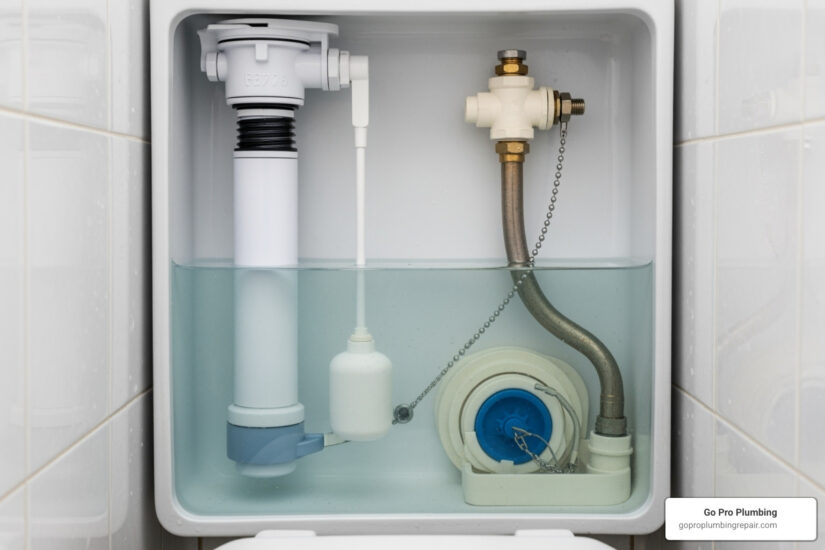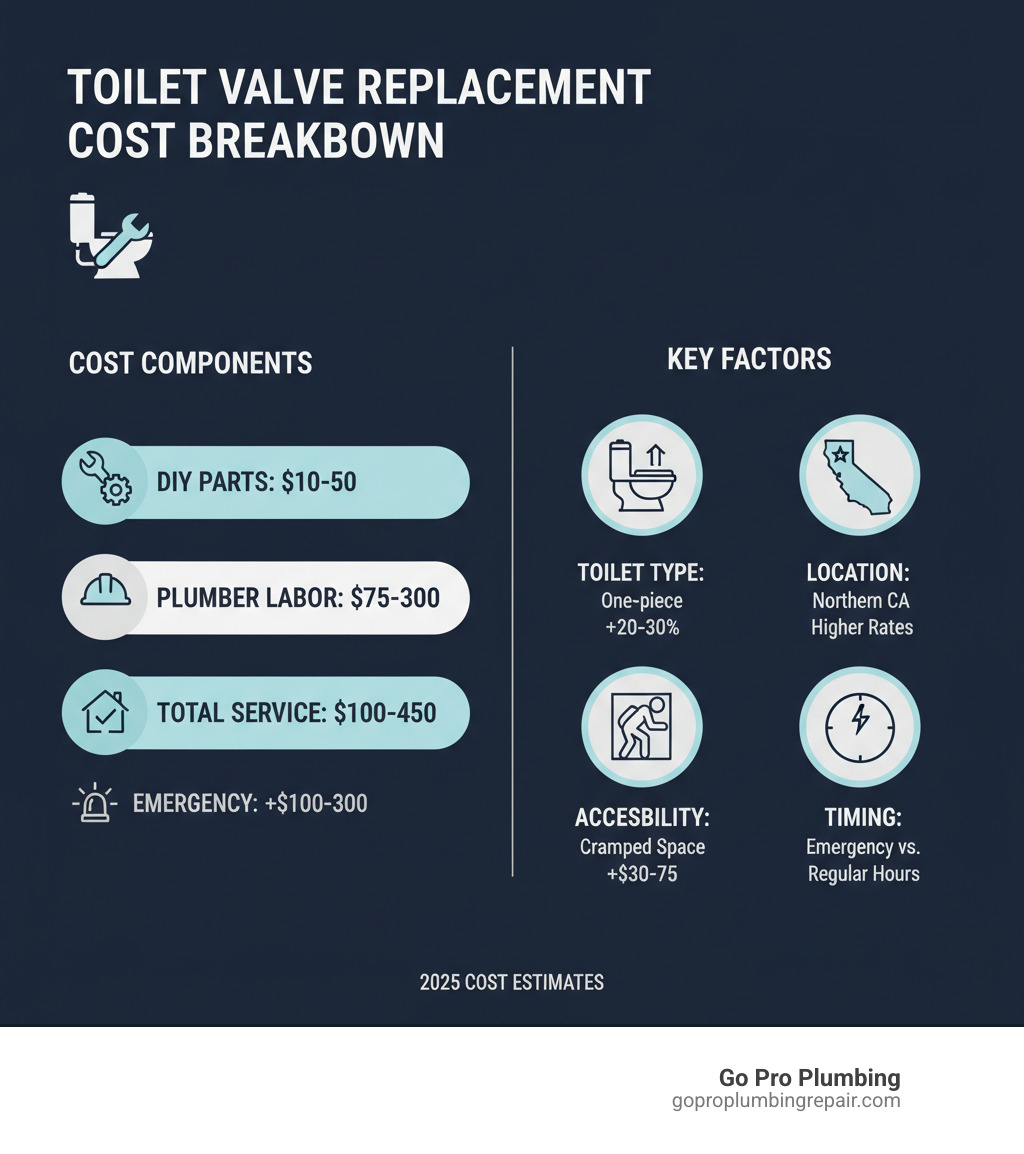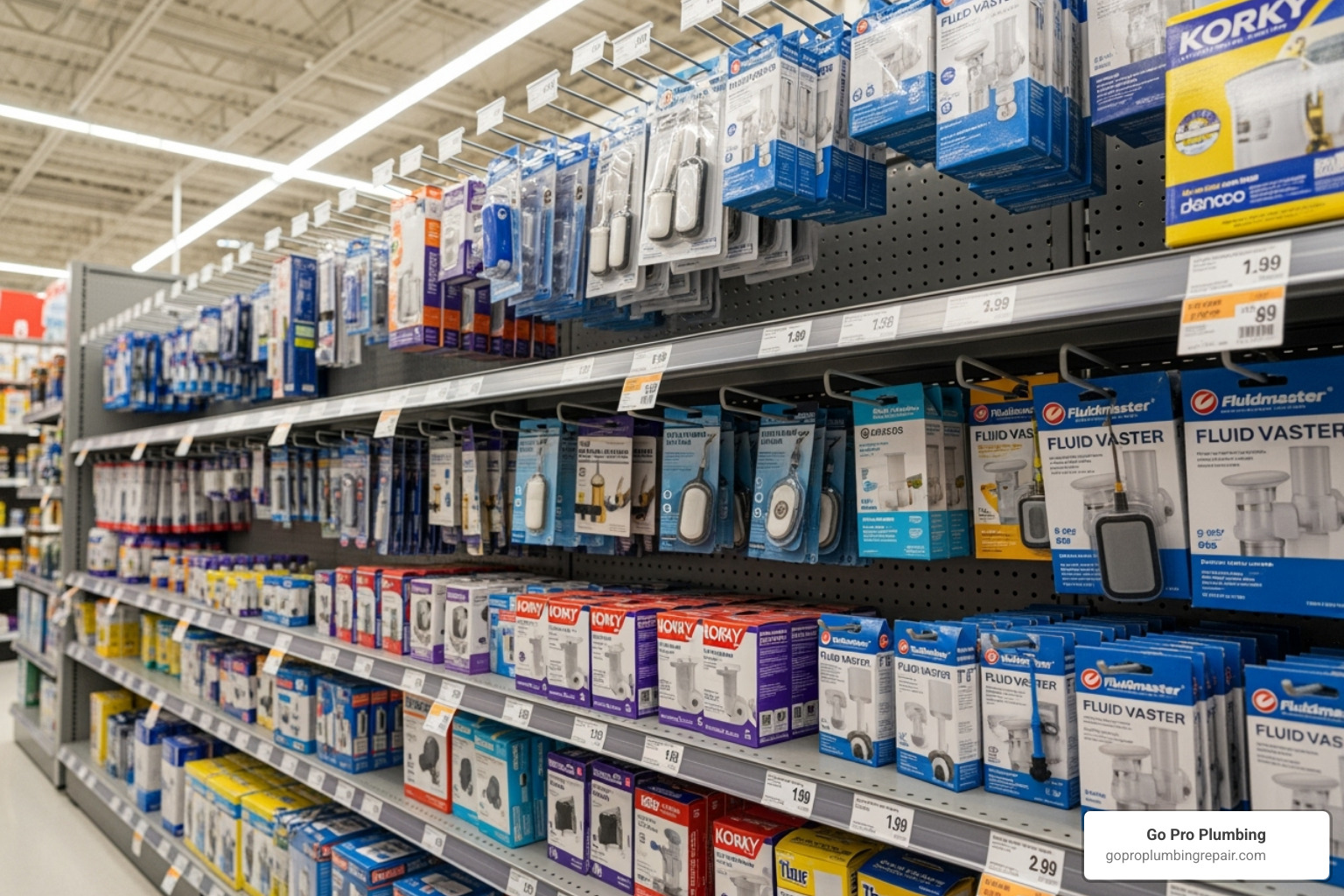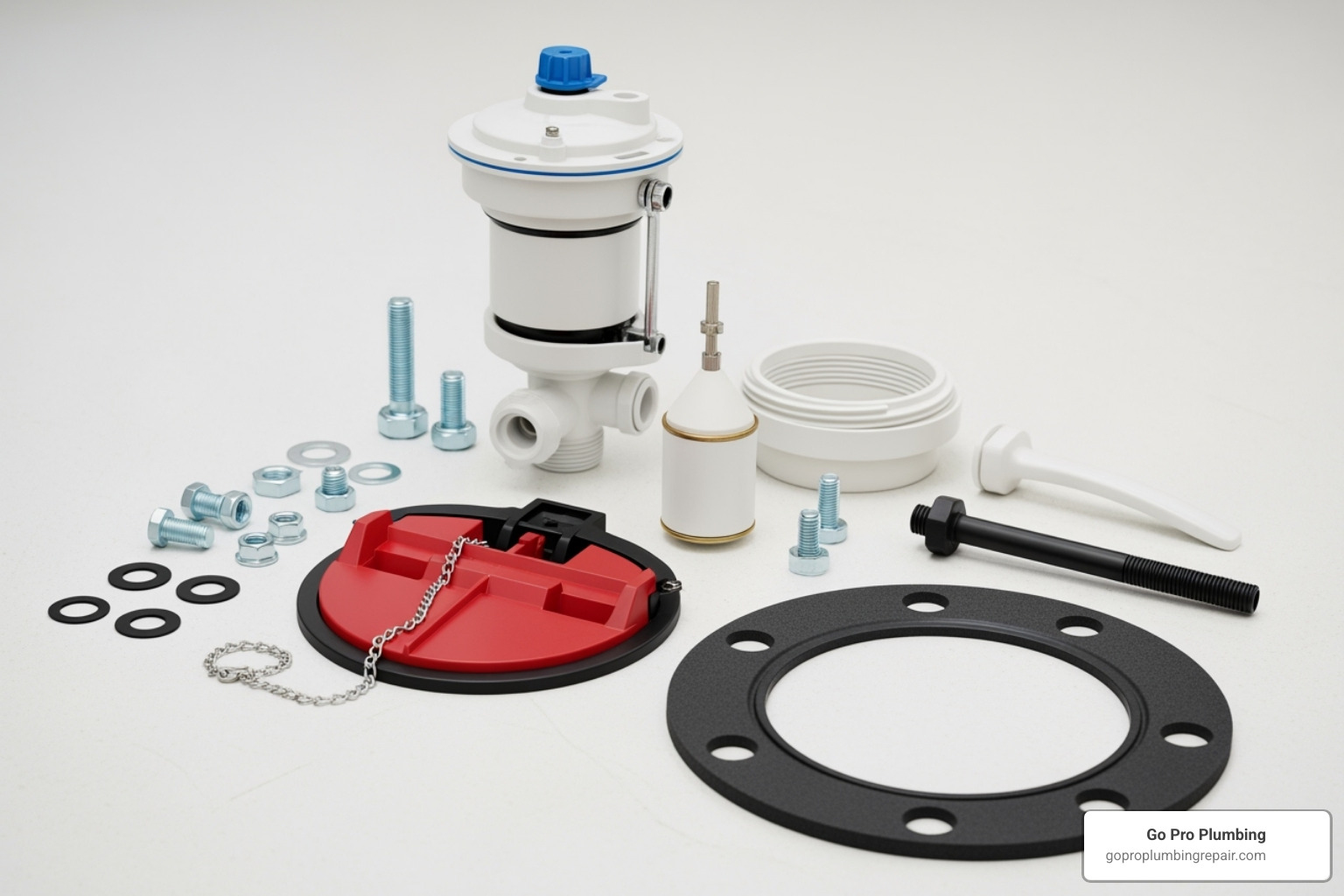Don’t Get Flushed: Understanding Toilet Valve Replacement Expenses
By Brian on October 27, 2025

Why Understanding Toilet Valve Replacement Cost Matters for Northern California Homeowners
Toilet valve replacement cost typically ranges from $100 to $450 depending on whether you’re tackling the job yourself or hiring a professional. Here’s what you need to know right away:
Quick Cost Breakdown:
- DIY (Parts Only): $10-$50
- Professional (Parts + Labor): $100-$450
- Fill Valve Only: $100-$200
- Fill Valve + Supply Line: $100-$200
- Fill Valve + Flapper: $159-$325
- Emergency Service: Add $100-$300
If you just heard that constant hissing sound from your toilet or noticed your water bill creeping up, you’re probably dealing with a failing toilet valve. One homeowner on a popular forum recently questioned a $365 charge from their property manager for replacing a fill valve and supply line—a repair that typically costs between $100 and $200 when hiring a plumber directly.
The reality is simple: toilet valves don’t last forever. Most fill valves serve for about 4-7 years before they need replacement. When they fail, you’re not just dealing with an annoying sound—you’re literally watching your money flow down the drain through wasted water.
Labor accounts for 60-75% of the total professional replacement cost, which is why understanding the breakdown helps you make smart decisions. Whether you’re comfortable with basic DIY repairs or prefer the peace of mind that comes with professional service, knowing what’s reasonable to pay protects you from overpaying.
In Northern California, where plumber hourly rates range from $75 to $150, these costs can add up quickly. But they don’t have to be a mystery.

Breaking Down the Toilet Valve Replacement Cost
Let’s talk numbers. When your toilet starts running or making that annoying hissing sound, you need to know what you’re facing financially. The toilet valve replacement cost isn’t as straightforward as you might hope, but understanding the breakdown helps you budget and avoid surprises.

Across the country, most homeowners pay between $100 and $200 for a professional to replace a fill valve and supply line. That’s the typical job that solves most running toilet problems. If you’re dealing with both a fill valve and flapper replacement, expect costs to range from $159 to $325. For a complete flush valve replacement, the national average sits around $271.
Here’s something important to understand: labor makes up 60-75% of your total bill. Those parts sitting in the hardware store? They’re actually pretty affordable. It’s the expertise, experience, and time of a skilled plumber that accounts for most of what you’re paying.
In Northern California—including Sacramento and Rancho Cordova where we serve—plumber hourly rates typically run from $75 to $150. Our region’s higher cost of living means you’ll often see prices toward the upper end of national averages. That’s just the reality of doing business here, but it also reflects the quality of service you receive.
Cost of Parts: What Are You Paying For?
The good news? The actual hardware won’t break the bank. A standard fill valve costs between $10 and $50 if you’re buying it yourself at the hardware store. A flush valve part runs about $20 to $30. Supply lines are usually inexpensive, often just a few dollars, and many plumbers include them in the fill valve replacement as a standard practice.
Many homeowners prefer universal repair kits because they come with everything you need in one box. The Universal 3-in. Complete Toilet Flush Valve Repair Kit is a popular choice that includes step-by-step instructions. High-performance valves might cost a bit more upfront, but they often last longer and work more efficiently. If you’re interested in upgrading to a dual-flush system for better water conservation, conversion kits typically cost $25 to $50.
Want to understand all the components inside your toilet tank? Our guide on plumbing materials for toilet breaks down everything you need to know.
Labor Costs: The Price of Professional Expertise
When you call a plumber, you’re paying for more than just someone to twist a wrench. You’re investing in years of training, specialized tools, and the confidence that comes from knowing the job will be done right the first time. No leaks, no callbacks, no frustration.
Professional plumbers in Northern California charge between $75 and $150 per hour, depending on their experience and your specific location. But here’s the thing—many plumbing companies, including us at Go Pro Plumbing, use flat-rate pricing for common repairs like valve replacements. This means you know the exact cost before we start working. No watching the clock, no surprise bills. A typical fill valve replacement takes about 1-2 hours, so you know what to expect.
Trip charges are sometimes listed separately, or they might be rolled into the flat rate. Either way, a reputable plumber will be transparent about all costs upfront. One thing to watch out for: emergency service fees. If you need help at 2 AM on a Sunday, expect to pay an additional $100 to $300. That’s why we always recommend addressing toilet issues during regular business hours when possible—it can save you serious money.
Our plumber for toilet repair page has more information about what to expect when you call for professional service.
Key Factors That Influence the Total Toilet Valve Replacement Cost
Not every toilet valve replacement costs the same. Several factors can push your final bill up or bring it down, and understanding them helps you anticipate what you’ll actually pay.
Your location matters more than you might think. Northern California costs run higher than many other parts of the country. Our local economy, demand for skilled tradespeople, and general cost of living all play a role. What costs $100 in rural Iowa might easily be $175 here in Sacramento.
The type of toilet you have makes a real difference. Standard two-piece toilets—the kind most homes have—are straightforward to work on. One-piece toilets, with their sleek integrated design, can be 20-30% more labor-intensive because accessing the valves is trickier. Wall-hung toilets? Those can potentially double your labor costs since the plumber needs to access components hidden behind your wall.
Bathroom accessibility sounds like a minor detail, but it’s not. If your toilet is wedged into a tight corner or surrounded by cabinets, expect to add $30 to $75 to your bill. Working in cramped spaces takes more time and requires more patience from your plumber.
Bundling multiple repairs actually saves you money. If you need several things fixed—maybe a valve replacement, a leaky faucet, and a clogged drain—having them all done in one visit reduces the per-job labor cost. It’s more efficient for everyone involved.
Watch out for property manager markups. Homeowner who got charged $365 for a $150 repair? Property managers sometimes add significant fees on top of the actual plumbing cost. Always ask for an itemized breakdown showing parts and labor separately. You have the right to know what you’re paying for.
Urgency comes with a price tag. Emergency calls during evenings, weekends, or holidays typically add $100 to $300 in surcharges. If your toilet can wait until Monday morning, you’ll save that money.
Unexpected complications can increase costs too. Corroded bolts might add 30 to 60 minutes to the job. A seized shut-off valve might need replacement before the plumber can even start on the actual toilet repair, adding $130 to $300. In areas with hard water, mineral buildup can make parts stubborn to remove, extending labor time.
For a broader look at what toilet repairs typically cost, check out our guide on cost to repair toilet. Understanding these factors puts you in control and helps you make smart decisions for your home and budget.
DIY vs. Hiring a Professional: A Cost-Benefit Analysis
When your toilet starts acting up, you’re probably standing there wondering: “Should I tackle this myself or call someone who actually knows what they’re doing?” It’s a fair question, and honestly, the answer depends on your comfort level with tools, how complex the problem is, and what makes sense for your wallet.

Let’s talk dollars first. If you go the DIY route for a simple fix, you’re looking at spending just $10 to $50 on parts—that’s it. Compare that to the toilet valve replacement cost of $100 to $450 when you hire a professional, and the savings are pretty obvious. For straightforward repairs like swapping out a fill valve or flapper, you could pocket that extra hundred bucks.
But here’s the thing: money isn’t the only factor. You’ll save on labor costs, but you’re trading that for your time—typically 1 to 3 hours if you’re new to this. And if we’re being honest, there’s always the risk that something could go sideways. An improperly installed valve might leak, and suddenly you’re dealing with water damage that costs way more than the original repair would have.
When you hire a professional, you’re paying for more than just someone to turn a wrench. You’re getting expertise, the right tools, and most importantly, a warranty on the work. If something goes wrong, they fix it. That peace of mind is worth something, especially when you’re dealing with water—which, as we all know, has a talent for finding places it shouldn’t be.
Here’s how the two options stack up:
| Feature | DIY | Professional Service |
|---|---|---|
| Cost | $10-$50 (parts only) | $100-$450 (parts & labor) |
| Time | 1-3 hours (longer if you’re learning) | 1-2 hours (done efficiently) |
| Complexity | Best for simple, straightforward repairs | Handles everything, including surprise problems |
| Warranty | You’re on your own | Work and parts typically covered |
| Risk | Mistakes can lead to leaks or damage | Minimal—experts know what they’re doing |
| Peace of Mind | Depends on your confidence | High—you know it’s done right |
The DIY Route: Saving Money on Simple Repairs
If you’re reasonably handy and the thought of working on your toilet doesn’t make you break out in a cold sweat, DIY can be a smart move for simple repairs. The parts-only cost is minimal—usually just $10 to $50 for a fill valve or flapper. You can pick up a universal repair kit at any hardware store, and many come with instructions that actually make sense.
Standard two-piece toilets are your best bet for DIY work. They’re easier to access, and the parts are straightforward to replace. If your toilet is constantly running or taking forever to refill, and you’ve figured out it’s the fill valve causing the trouble, you can probably handle this yourself. Many first-timers successfully replace a flapper in about 30 minutes, which is honestly pretty satisfying.
Just remember the golden rule: turn off the water supply before you start. Trust us on this one. If you need step-by-step guidance, our article on [how to fix a running toilet](https://goproplumbingrepair.com/how-to-fix-a-running-toilet/) walks you through the process in plain English.
The time commitment is real, though. Plan for 1 to 3 hours depending on your experience level and whether you run into any surprises. But if you’re saving $100 or more and you enjoy this kind of project, it’s time well spent.
When to Call a Plumber: The Value of Professional Service
Now, let’s talk about when DIY becomes a bad idea. Some toilet problems are more complicated than they look, and that’s when calling a professional makes sense—both financially and for your sanity.
One-piece toilets are a perfect example. Their integrated design makes them 20-30% more labor-intensive to work on. If you’ve got a wall-hung toilet, you’re looking at accessing components behind the wall, which requires specialized knowledge and tools. These aren’t good candidates for your first DIY plumbing adventure.
Corroded parts are another red flag. If you’ve got seized tank bolts or a shut-off valve that won’t budge, forcing it can crack the porcelain or strip the pipes. What started as a $150 repair suddenly becomes a $500 disaster. Professional plumbers have the right tools and experience to handle corroded parts without causing damage.
Water damage risk is the big one, though. A small leak from an improperly installed valve can cause serious damage to your flooring, subflooring, and even the ceiling below if you’re on an upper floor. The cost of repairing water damage quickly dwarfs what you’d pay for professional installation in the first place.
When you hire a pro, you’re also getting warranty protection. If something goes wrong with the parts or the installation, they come back and fix it at no extra charge. That’s not something you get with DIY.
The [demand for plumbers](https://www.bls.gov/ooh/construction-and-extraction/plumbers-pipefitters-and-steamfitters.htm#tab-6) remains consistently high, which tells you something: these skills are valuable because they’re specialized. If you’re dealing with multiple issues, corroded components, or a toilet type that’s tricky to work on, the smart money is on professional help.
At Go Pro Plumbing, our [toilet repair services](https://goproplumbingrepair.com/toilet-repair-services/) handle everything from basic valve replacements to complex repairs. We’ve seen it all, and we know how to get it done right the first time. Sometimes the most cost-effective decision isn’t the cheapest one upfront—it’s the one that saves you from bigger headaches down the road.
Beyond the Fill Valve: Understanding Related Repairs and Costs
Here’s something many homeowners find the hard way: when one part of your toilet fails, it’s often not alone. Your toilet’s components age together, and that hissing fill valve might have a worn-out flapper keeping it company. Understanding these interconnected repairs can save you from multiple service calls—and the frustration that comes with them.

Think of it this way: if you’re already paying a plumber’s trip charge and labor to replace your fill valve, inspecting and potentially replacing the flapper at the same time just makes sense. The additional cost is minimal compared to scheduling another visit in a few months when the flapper finally gives up.
Beyond the tank components, other common toilet repairs include wax ring replacement when you notice water pooling around the base of your toilet. The wax ring itself costs just $2-$10, but professional replacement runs $50-$200 because your plumber needs to remove and reset the entire toilet—it’s heavy work that requires precision to prevent leaks.
Toilet flange repair is another related service. The flange secures your toilet to the drainpipe and floor, and when it’s damaged, your toilet wobbles or leaks. Professional flange repair typically costs $145-$165, with parts running $7-$20. This is definitely a job for the pros, as it involves working with the drainpipe connection and ensuring a proper seal.
And remember that property manager markup we discussed earlier? It applies to all these repairs, not just fill valves. Always request an itemized breakdown showing exactly what you’re paying for—parts, labor, and any administrative fees.
Replacing the Fill Valve and Flapper: A Common Combo
When your plumber opens your toilet tank, they’re likely checking more than just the fill valve. The flapper—that rubber seal at the bottom of the tank that controls water flow into the bowl—works in tandem with your fill valve. If one is showing its age, the other probably is too.
The combined toilet valve replacement cost for both a fill valve and flapper typically ranges from $159 to $325 when done professionally. If you’re only dealing with a bad flapper and want to tackle it yourself, you’ll spend just $5-$15 for the part. A plumber might charge $50-$100 for a flapper-only replacement, which is still reasonable considering it’s a quick fix that could save you significant water waste.
Why replace both components together? Simple economics and common sense. You’re already paying for the service call and the plumber’s time. Adding a flapper replacement adds minimal cost but prevents that inevitable situation where your newly replaced fill valve works perfectly, but two months later you’re calling again because the old flapper has finally worn through.
Ghost flushing—when your toilet randomly flushes itself without anyone touching it—is the telltale sign of a bad flapper. You might also notice a constant trickle of water running from the tank into the bowl, which means that rubber seal isn’t doing its job anymore. Both symptoms translate to wasted water and higher bills.
For detailed information about flush valve components and their replacement costs, visit our guide on [toilet flush valve replacement cost](https://goproplumbingrepair.com/toilet-flush-valve-replacement-cost/).
Recognizing the Signs: When Does Your Toilet Valve Need Replacement?
Your toilet is actually pretty good at telling you when something’s wrong—you just need to know what to listen for. That constant hissing sound from your tank? That’s not background noise you should ignore. It’s your fill valve crying for help, unable to shut off properly after refilling. This sound literally represents money flowing down the drain, sometimes hundreds of gallons per day.
Ghost flushing is another unmistakable sign. When your toilet decides to flush itself in the middle of the night, it’s not haunted—it’s got a slow leak from the tank into the bowl. The water level drops gradually, triggering the fill valve to kick in and refill the tank. This cycle repeats endlessly, wasting water with each phantom flush.
Notice your toilet tank taking forever to refill after a flush? A slow tank refill usually points to a partially clogged or failing fill valve that can’t deliver water at the proper rate. Conversely, a weak flush might mean your tank isn’t filling to the correct level, leaving you with inadequate flushing power.
Sometimes the warning signs are visual. Open your toilet tank and take a look inside. Excessive mineral buildup coating the fill valve, visible cracks in any components, or deteriorating rubber seals that look brittle or discolored all indicate it’s time for replacement. Hard water accelerates this deterioration, especially here in Northern California where mineral content can be high.
Perhaps the most painful sign? An unexplained spike in your water bill. A constantly running toilet can waste 200-300 gallons of water daily. That adds up fast on your monthly bill.
Most fill valves last about 4-7 years under normal conditions. While you don’t need to mark your calendar for preventative replacement, knowing this lifespan helps you anticipate when problems might arise, especially if you know your toilet’s age.
If you’re experiencing any of these symptoms, our comprehensive guide on [running toilet repair](https://goproplumbingrepair.com/running-toilet-repair/) walks you through diagnosis and solutions. The sooner you address these issues, the more water—and money—you’ll save.
Frequently Asked Questions about Toilet Valve Replacement
We know you’ve got questions, and we’re here to provide clear, honest answers based on what we see every day in homes across Northern California.
How long does a toilet fill valve replacement take?
When you call a professional plumber like our team at Go Pro Plumbing, a standard toilet fill valve replacement is a relatively quick job—usually about 1 to 2 hours from start to finish. We show up with fully-stocked trucks, so we’re not making extra trips to the hardware store on your dime.
If you’re tackling this as a DIY project, give yourself a bit more breathing room. Plan for 1 to 3 hours, especially if this is your first rodeo with toilet repairs. There’s a learning curve, and it’s better to work carefully than to rush and create a bigger problem.
That said, not all valve replacements go smoothly. Sometimes you encounter those stubborn, corroded bolts that just won’t budge—they can easily add 30 to 60 minutes to the job. Even trickier is when the shut-off valve behind your toilet is seized up or leaking. In that case, it needs to be replaced before we can even touch the fill valve, which adds another $130 to $300 to your total cost and extends the timeline.
Are there different types of toilet fill valves and do they vary in cost?
Yes, there are several types of toilet fill valves, though they all do essentially the same job—they refill your toilet tank after each flush. The most common types you’ll come across are float-cup valves, which use a floating cup that rides up and down with the water level to control the fill. Then there are diaphragm-style valves, which tend to be more compact and use a diaphragm mechanism to manage water flow. Newer designs include floatless valves that use pressure sensing instead of a physical float, giving your tank a cleaner, more modern look inside.
Here’s the good news: most modern toilets use a universal design, which means a standard replacement fill valve from your local hardware store will fit just fine. These universal kits typically cost $10 to $50 for the part alone. However, if you have a high-end toilet or an older model with unique specifications—certain Kohler toilets come to mind—you might need a brand-specific part that could cost a bit more.
The reality is that the cost variation between different types of functional fill valves isn’t huge unless you’re getting into specialized or smart toilet components. For most homeowners, a quality universal fill valve will do the job beautifully.
Is it cheaper to replace the whole toilet instead of just the valve?
This is one of the best questions we get, and it really depends on your specific situation. In most cases, replacing just the valve is far more economical. A toilet valve replacement cost typically runs $100 to $450 when you hire a professional, while replacing an entire toilet—including the new unit and installation—usually costs $350 to $800, and that’s for a basic model. Luxury toilets can run much higher.
However, there are times when replacing the whole toilet actually makes more financial sense. If your toilet is over 25 years old, you’re probably looking at an appliance that’s nearing the end of its useful life. Repairs might start piling up, turning what seems like savings into a money pit.
If you’re dealing with frequent clogs that persist even after repairs, you might have an inefficient older model that just can’t handle modern demands. And if you spot any cracks in the porcelain—whether in the bowl or tank—there’s no repair for that. The toilet needs to go.
One of the biggest factors to consider is water efficiency. Older toilets can guzzle 3.5 to 7 gallons per flush. That’s a lot of water! Modern toilets, regulated since 1994, use 1.6 gallons per flush or less. Many newer models use just 1.28 gallons or feature dual-flush options for even better efficiency. The EPA has documented that [newer toilets can save you quite a lot](https://www.epa.gov/watersense/residential-toilets) on your water bill over time.
A helpful rule of thumb: if your repair cost (parts plus labor) exceeds 50% of the cost of a new toilet with installation, you’re probably better off replacing the whole unit. You’ll get better water efficiency, fewer future repairs, and peace of mind knowing everything is new and under warranty.
So while a valve replacement is usually the smart immediate fix, it’s worth taking a step back to consider the bigger picture—especially if your toilet has been giving you multiple headaches lately.
Conclusion: Making a Cost-Effective Decision for Your Home
You’ve made it through the numbers, the options, and the considerations—and now you’re equipped to make the right call for your home. Understanding toilet valve replacement cost isn’t just about knowing that it ranges from $10-$50 for a DIY parts run to $100-$450 for professional service. It’s about recognizing what makes sense for your situation, your budget, and your peace of mind.
The DIY route can absolutely save you money on straightforward repairs like replacing a flapper or fill valve in a standard two-piece toilet. But when you’re facing corroded parts, one-piece toilets, cramped bathroom spaces, or anything that could lead to water damage, professional expertise becomes worth every penny. A licensed plumber brings more than just tools—they bring years of experience, warranty protection, and the confidence that your repair will last.
Here’s something worth remembering: investing in timely repairs today prevents much bigger expenses tomorrow. A constantly running toilet can waste hundreds of gallons of water daily, turning a $150 repair into hundreds of dollars in wasted water bills over just a few months. And upgrading to a water-efficient toilet? That’s a gift that keeps giving, month after month, year after year.
We’ve been helping homeowners throughout Northern California—from Sacramento to Rancho Cordova and beyond—solve their toilet troubles for years. At Go Pro Plumbing, we know that plumbing emergencies don’t wait for business hours, which is why we offer same-day service with transparent, upfront pricing. Our technicians show up with fully-stocked trucks, ready to handle whatever your toilet throws at us (metaphorically speaking, of course).
Whether it’s a simple fill valve swap or a more complex repair, we’re committed to getting it done right the first time. No surprises, no runarounds—just honest service from neighbors who care about your home as much as you do.
Ready to stop worrying about that running toilet? Our friendly team is standing by to help. Visit our [toilet services](https://goproplumbingrepair.com/services/toilets/) page to learn more about what we offer, or give us a call to schedule your service. Because honestly, life’s too short to listen to a constantly running toilet. Let’s get your bathroom back to being the peaceful retreat it should be.
